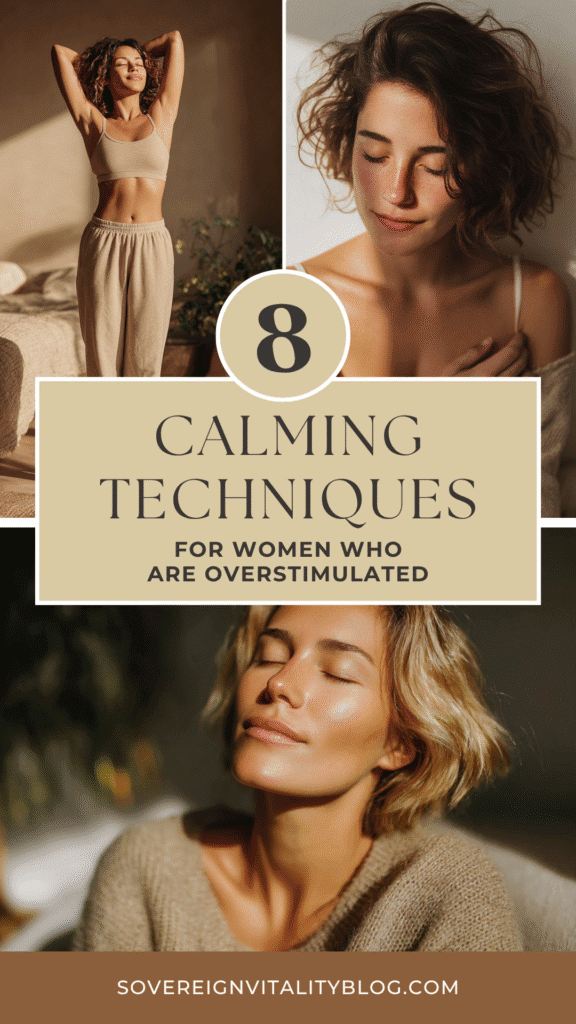This post may contain affiliate links, including those from Amazon Associates. If you make a purchase through these links, I may earn a commission at no additional cost to you. Learn more about our affiliate policy.
Some days the world feels too loud. The lights glare, notifications ping, and your nervous system is already carrying the weight of multitasking, decision fatigue, and a long list of unfinished thoughts.
For women especially, the combination of caregiving, constant inputs, and the invisible load of daily life can tip into overstimulation before we even notice what’s happening.
When I find myself in that place, my mind buzzing, body tense, everything feeling “too much”, I’ve learned to pause and reach for simple techniques that help me reset.
They don’t take much time, most can be done anywhere, and each one works with the body’s own rhythms to bring a sense of calm back online.
If you’ve been feeling overstimulated lately, these eight quick calming techniques might be the steadying breath you need.

Understanding Overstimulation
Overstimulation happens when your senses, emotions, or mind receive more input than they can process. It can show up as irritability, restlessness, brain fog, or an urgent need to escape from noise and activity.
Common triggers include crowded places, too much screen time, multitasking without breaks, or even emotional intensity in relationships and work.
Your body tries to protect you by heightening alertness, but the cost is a nervous system stuck in “fight or flight.”
The good news is that quick calming techniques work with your body’s natural ability to self-regulate. Think of them as little resets, gentle signals that it’s safe to soften.
If you’re not sure whether what you’re feeling is truly sensory overload, you may find it helpful to read about the 7 signs your nervous system is overstimulated.
1. Grounding Through the Five Senses
One of the fastest ways I’ve found to interrupt overwhelm is grounding through the senses.
A simple 5-4-3-2-1 technique can be done anywhere. Pause and notice five things you see, four things you hear, three things you feel, two things you smell, and one thing you taste.
Another option is simply pressing your feet firmly into the floor and noticing the support beneath you. If you carry a small tactile object—like a smooth stone or piece of fabric, you can hold it and pay attention to its texture.
This works because it shifts your focus away from the racing mind and anchors you in the present moment.
2. Box Breathing

Breathing is the nervous system’s built-in reset button. When you’re overstimulated, the breath often becomes shallow and fast. Box breathing is a simple way to slow everything down. Inhale for four counts, hold for four, exhale for four, hold for four, and repeat.
You can shorten the count to three if that feels easier.
Picture tracing the sides of a square as you breathe: inhale up one side, hold across the top, exhale down, hold across the bottom. Even a minute or two can bring noticeable calm.
3. Progressive Muscle Relaxation
Sometimes overstimulation shows up as tension locked in the body. Progressive muscle relaxation helps release that tightness in just a few minutes.
Starting at your feet, gently tense a muscle group as you breathe in, then release as you exhale. Work your way up through calves, thighs, belly, shoulders, and face.
If you don’t have time for a full scan, focus on your shoulders and jaw, two places that hold stress almost instantly. The act of tensing and releasing sends the signal that it’s safe to let go.
4. Guided Imagery

When everything feels “too much,” stepping into an inner sanctuary can be powerful. Guided imagery simply means closing your eyes and imagining yourself in a calming place, perhaps a quiet forest path, a cozy cabin with soft blankets, or the gentle rhythm of waves on a shore.
Engage your senses in the scene. What do you hear, smell, or feel against your skin? Even two or three minutes of visualization can help your body follow your mind into a calmer state.
I keep a few favorite images ready: sunlight flickering through trees, the hush of a library, the scent of lavender fields. Practicing them when I’m already calm makes it easier to call them up when I need relief.
5. Sensory Soothers

For some women, overstimulation is rooted in sensory overload. The fastest way to ease it is to give the body a soothing input it can rely on.
This could be wrapping a soft blanket around your shoulders, holding a warm mug of tea, or carrying a small fidget that feels grounding to the touch.
At home, weighted blankets or lap pads work beautifully, but even in public, subtle tools like a textured bracelet or stress ball can help. These simple tactile cues remind your nervous system that it’s safe to downshift.
6. Calming Music or Ambient Sound
Sound can be both a trigger and a healer. Creating a playlist of slow, ambient music gives you something to reach for when you feel on edge. Choose songs with a gentle tempo, soft tones, or even nature sounds.
If music feels like too much stimulation, try white noise, rain sounds, or a calming hum.
Noise-canceling headphones can also create a pocket of relief in crowded environments. Your nervous system naturally entrains to rhythm, so letting sound set a slower pace is a quick reset.
7. Gentle Movement

When overstimulated, the body often holds onto the energy, creating a restless, buzzing feeling. Gentle movement helps discharge it.
Try rolling your shoulders, stretching arms overhead, or leaning into a forward fold. If you’re at home, child’s pose or a few minutes of swaying with soft music can be grounding.
Even a short walk around the block, letting your eyes rest on trees or sky, can shift your state. Movement tells the body it has an outlet, easing tension without requiring intense exercise.
8. Self-Compassion Pauses

Finally, one of the most overlooked tools is a simple pause to speak kindly to yourself.
Overstimulation often comes with self-criticism: “Why can’t I handle this?”
A loving phrase can interrupt that spiral. Place a hand over your heart, take a slow breath, and whisper something like, “I’m safe right now,” or “It’s okay to rest.”
This may feel small, but self-compassion lowers stress hormones and soothes the emotional side of overwhelm.
With practice, it becomes a quick habit that helps you soften into calm instead of pushing through.
Putting It All Together
The beauty of these techniques is how portable they are. You don’t need a quiet room, a full hour, or special tools to reset your system. Most can be done in under five minutes, even in a busy day.
What I’ve found is that practicing them when I’m already calm makes them more effective when I’m not. Over time, my nervous system learns these as “safe cues,” so the transition into calm happens faster.
You don’t need to try all eight at once. Start with one or two that feel natural, and experiment with layering them when needed. Maybe grounding plus box breathing helps you in crowded spaces. Or a soft playlist paired with a warm cup of tea carries you through the evening wind-down.
On days when you feel especially overloaded, it can be supportive to dedicate time to a full nervous system reset day routine that gives your body and mind the space to fully unwind.
The key is listening to your own body and honoring what works for you.
A Gentle Reminder
If you find yourself overstimulated daily, unable to cope, or sliding into panic, it may help to reach out for professional support.
Therapists and occupational specialists can guide you in building a personalized toolkit. There’s no shame in seeking help. It’s another form of sovereignty, choosing care that sustains your well-being.
Closing Thoughts
Life isn’t always quiet. The world will keep offering bright lights, buzzing phones, and endless to-dos. But you have the power to carve out moments of calm within it.
These techniques are simple tools, not solutions to every problem. Still, they can change the texture of a day, soften the edges, and remind you that calm is always available, even in small doses.
If you’re longing for more ideas, you might also enjoy exploring simple nervous system resets or crafting an evening routine that helps your body feel safe to rest. Every small step you take toward calm is a gift to yourself and the ones you love.



